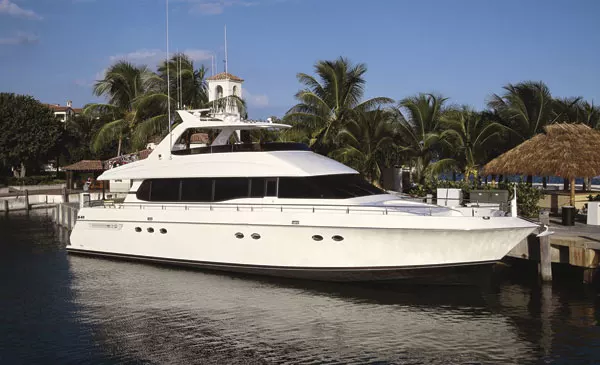Lazzara 76 – Used Boat Review

As a yacht for boat guys to drive themselves or offer for charter, the Lazzara 76 showed forward thinking in her layout and execution.
The premiere model produced by Lazzara Yachts was a 76-footer splashed in 1992. More than 20 years later it’s still sought after by both the hands-on, capable owner and those looking for an efficient and manageable crewed charter yacht.
The Lazzara Yachts boatbuilding legacy traces back through three generations. Vince Lazzara had success building Columbia sailboats and Gulfstar sail and motoryachts. His sons, Dick and Brad, founded the Tampa, Florida-based manufacturer in 1990 and they and their sons now carry on the tradition.
“In the late 1980s Dick and Brad Lazzara started seeing a trend in the market for larger motoryachts that could be an owner-operated as well as captained yacht,” reflects Rich Lazzara, vice president of sales and marketing at Lazzara. “There was a real need in the market above 65 feet for a yacht that had contemporary styling and yet did not compromise on amenities. The Lazzara 76 was born out of years and years of boatbuilding experience and a true understanding of what the market was asking for.”
The builder produced 48 units in total from 1992 to 2002. The six-head, five-stateroom layout is spectacular for either coastal or long-distance cruising. Her shallow draft—a mere 4 feet 6 inches—allows access to skinny-water bays inaccessible to other yachts of this size.
“This Lazzara is user friendly and easy to control. I rarely use the thruster; she handles well when docking,” says J.P. De Wet Steyn, captain of the 76-foot Sea Journey. “There are two cranes for untroubled on-and-off of our tenders, that’s very helpful when we’re chartering. Our quarters have a separate washer and dryer and there’s plenty of storage for provisions. It’s an easy boat for [my wife and crew] Madeline and I to entertain a charter.”
The accommodations are split into two areas with two staterooms forward and three amidships, preventing overcrowding in a single segment. When in charter mode, the crew’s quarters forward are isolated from the guests. It’s an unencumbered unit with a twin-berth forward and bunks to port, a study and, incredibly, two heads.
Looking forward into the saloon, one can see the low-maintenance padded-panel interior.
Off the saloon a circular staircase leads to a companionway and the centerpiece of the main accommodations section, the full-beam master with king berth. All appointments and joinery exude quality workmanship and functionality and seem to hold up well over the years. New owners can certainly update where needed with soft goods and appointments for a fresher, personal touch.
Two other staterooms, each with private head, have queen berths. Some of the 76s were built with the “excuse me, honey” berths, with one side flush against the hull ceiling, rather than island berths. A few of those have been retrofitted with island berths—that certainly is a plus. A washer-and-dryer set is dedicated for owners’ use in a companionway locker.
Lazzara’s two most popular options were the wide-body deckhouse and the highly sought-after skylounge flying bridge. Of the 48 units produced, 30 were wide-bodies and 30 sported skylounges, though not all wide-bodies necessarily had the lounge.
“At the time we were the only company offering a fully enclosed skylounge flying bridge at that size,” reports Lazzara.
The Sea Journey is the walkaround style with wide, 360-degree side decks. Still, the saloon takes serious advantage of the 19-foot beam. It easily supports a vast amount of seating on facing settees, a large dining table, and an entertainment center. A forward bulkhead houses cabinetry and a bar; this bulkhead serves as a divider from the galley.
The wide-body option further increases the interior volume of the saloon. Owners should evaluate that addition in relation to sacrificing the side decks and dual side doors flanking the lower helm (the starboard-side door remains on the wide-body model) that offers the operator and crew access to the decks from either side. My preference, certainly as an owner-operator, would be the walkaround.
The galley is another high point of the Lazzara design. It’s billed as a country kitchen and is size-appropriate for a 76-foot yacht of this design. The forward bulkhead easily holds a full-size, side-by-side refrigerator and oven with stovetop. Above the oven is a microwave. Cabinetry surrounds the space and a large sink doesn’t consume the counter area. Chef and server can smoothly perform their duties in the space. An L-shaped settee is to starboard next to the lower-helm area. A dayhead is cleverly concealed nearby.
The lower helm is behind a three-panel windshield. The line of sight forward is terrific; the portside door on the walkaround model provides an ample view aft. A double-wide helm seat and nicely designed console make it friendly to the captain. There’s plenty of flat dashboard real estate to accept a refit of modern electronics and navigation equipment. Reasonable access for rewiring and outfitting is below. A set of stairs contains stowage and leads up to the flying-bridge deck.
The flying bridge was built with either an open configuration or the aforementioned skylounge, while the open had a hardtop and helm station and was outfitted with the obligatory settees, tables, grills, refrigerator-freezer, and bar. There is still ample room for lounging, even with a tender stowed up top.
The skylounge flying bridge takes the space to luxurious levels by creating a richly appointed, enclosed, and climate-controlled helm and entertaining space. Owners’ preference for this option will be influenced by the climates in which they boat—it’s a season extender in colder environs—and nicely serves if an additional social locale is required. The skylounge also becomes a quiet pilothouse, isolated from noise and the elements.
The builder uses tri-axial fiberglass; the hull and deck are balsa-cored. Lazzara vacuum-bagged everything including hull bottom, sides, and all deck surfaces. A patented isolation mounting system, made up of hundreds of 4-inch-diameter discs placed on top of all the stringers, allows the interior module to actually “float” above the stringers reducing vibration and noise transfer to the interior accommodations, according to Rich Lazzara. The company pioneered this technology.
The 76 is powered by a pair of 1,150-horsepower MTU engines, the only available engine package. Published cruising speed is 21 knots at 2100 rpm. De Wet Steyn cruises the Sea Journey at 1800 rpm and, depending upon load, finds the GPS display showing around 18 knots.
Engine-room access is gained from the transom deck. The main engines, two generators, and ship’s systems are easily serviced in the compartment that allows the captain to stand up while working. Lazzara uses ISIS ship monitoring, which provides the operator vital information about the vessel on a display mounted at the helm.
On either side of the engine-room access at the transom there are large garage-style doors. These are gateways to stowage compartments large enough for PWCs, dive gear, and water toys. At anchor, the transom area is obliging to swimmers and the like.
There are a handful of 76s on the market, each with a different level of either refit or remodel. This will be clearly reflected in the listing price. Buyers should closely look at their individual needs, and also look at comparably sized yachts in the marketplace. While Azimut and Ferretti models in this size range give a nice turn of speed, their complexity may challenge the owner-operator. Similarly sized Hatteras motoryachts also are worth a look for comparison purposes.
When one considers that many manufacturers are now offering series builds, the Lazzara 76 was really ahead of its time. And many examples on the brokerage market seem to stand the test of time well, thanks to that build philosophy.
Specifications
- Builder: Lazzara
- Model: Lazzara 76
- Boat Type: Cruiser
- LOA: 76’0″
- Draft: 4’6″
- Beam: 19’0″
- Displacement: 110,000 lb.
- Fuel Capacity: 1,700 gal.
- Water Capacity: 350 gal.
- Standard Power: 2/1,150-mhp MTU 12V 183 TE93s
- Years Built: 1992 to 2002
- Price Range: $595
This article originally appeared in the March 2013 issue of Power & Motoryacht magazine.

